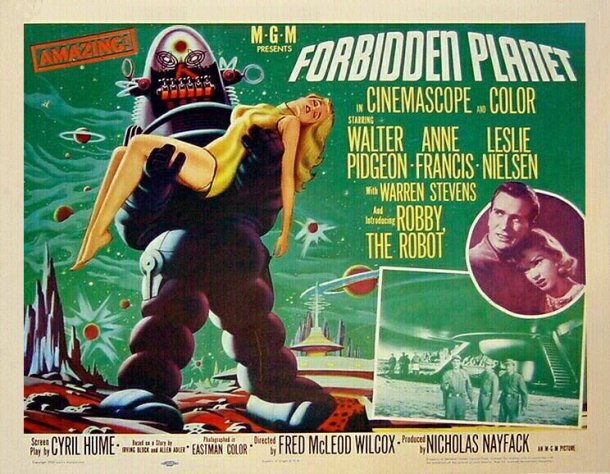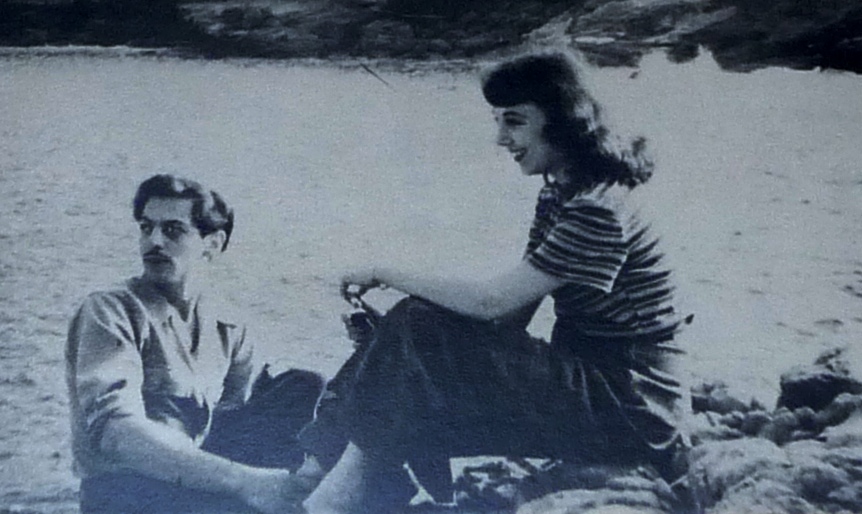For those of us obsessed with the early days of electronic music, the film, ‘Forbidden Planet’ represents a significant milestone. Louis and Bebe Barron’s phenomenal score is credited as the first all-electronic score in movie history. This predates the emergence of the infamous Moog synthesizer by eight years and, in actual fact, has roots extending into innovations from the late 40s. As a film, it’s difficult to place ‘Forbidden Planet’ on a pedestal above the bulk of big budget sci-fi flicks from the 50s. It’s certainly not a bad film and has plenty going for it but, in the opinion of this music geek, the score is the main reason to seek it out.
The score to ‘Forbidden Planet’ as we know it was the result of a chance encounter at a beatnik bar in New York between MGM producer, Dore Schary, and the Barrons. Upon witnessing their performance, Schary hired the duo to compose the score which, in order to avoid paying industry music guild fees, was called ‘electric tonalities’. One imagines that Schary was desperate to save money and decided upon what he viewed as a novelty in hiring the Barons. Whatever the motivations, this decision would prove to be a groundbreaking one.
Bebe and Louis Barron were a married couple whose interest in the exploration of sound cannot be understated. After marrying in 1947, the couple relocated to New York and were given a tape recorder as a wedding gift. This led to an immediate study of musique concrete techniques, which soon segued into an interest in electronic music. While their score for ‘Forbidden Planet’ would be the first electronic score in movie history, perhaps of more significance is a piece they composed in 1950 called ‘Heavenly Menagerie’, which is regarded as the first electronic composition made in America. This was primitive electronic music that took a painful amount of time to produce and involved physically cutting and arranging the tape. These electronic techniques, and the refined techniques that would become the score to ‘Forbidden Planet’ are grounded in the theories espoused in the 1948 book, ‘Cybernetics: Or, Control and Communication in the Animal and the Machine’ by mathematician, Norbert Wiener. Rather than attempt to explain how Wiener’s book inspired the Baron’s electronic work, here is the description from Wikipedia:
The 1948 book Cybernetics: Or, Control and Communication in the Animal and the Machine, by mathematician Norbert Wiener from MIT played an important role in the development of the Barrons’ composition.[5] The science of cybernetics proposes that certain natural laws of behavior apply to both animals and more complex electronic machines.
By following the equations presented in the book, Louis was able to build electronic circuits which he manipulated to generate sounds.[5] Most of the tonalities were generated with a circuit called a ring modulator. The sounds and patterns that came out of the circuits were unique and unpredictable because they were actually overloading the circuits until they burned out to create the sounds. The Barrons could never recreate the same sounds again, though they later tried very hard to recreate their signature sound from Forbidden Planet. Because of the unforeseen life span of the circuitry, the Barrons made a habit of recording everything.
Most of the production was not scripted or notated in any way. The Barrons didn’t even consider the process as music composition themselves. The circuit generated sound was not treated as notes, but instead as ‘actors’. In future soundtrack composition, each circuit would be manipulated according to actions of the underlying character in the film.
After recording the sounds, the couple manipulated the material by adding effects, such as reverb and tape delay. They also reversed and changed the speed of certain sounds[2]. The mixdown of multiple sounds was performed with at least three tape recorders. The outputs of two machines would be manually synchronized[3], and fed into an input of a third one, recording two separate sources simultaneously. The synchronization of future film work was accomplished by two 16 mm projectors that were tied into a 16 mm tape recorder, and thus ran at the same speed.
While Louis spent most of his time building the circuits and was responsible for all of the recording, Bebe did the composing. She had to sort through many hours of tape.[5] She described it, “it just sounded like dirty noise”. Over time, she developed the ability to determine which sounds could become something of interest. They may also have invented the tape loop. The tape loop gave the Barrons’ sounds rhythm. They mixed the sounds to create the otherworldly and strange electronic soundscapes required by Forbidden Planet.
This innovative approach to sound ultimately gave birth to one of the most stunning film scores to this day. It is a travesty to consider that the Barons were not eligible for an academy award in either the soundtrack or sound design categories because they were not members of the musicians union. This travesty is further compounded by MGM’s decision not to commercially release the soundtrack. What compounds this sequence of unfortunate events even more is the brief existence of a 7″ release of the original ‘Forbidden Planet’ theme which was discarded from the final film in favour of the Barons’ sound alchemy.
It wasn’t until 1976, in honour of ‘Forbidden Planet’s’ 20th anniversary that the soundtrack was finally released (of course) by the Barrons themselves on their own label, ‘Planet Records’. Since this time, the importance of this soundtrack has gained deserved prominence, especially amongst fans of electronic and experimental music. What follows is a selection of pieces from the soundtrack for your listening pleasure. The soundtrack is readily available and can be purchased here (among many other places).
…
[youtube=http://www.youtube.com/watch?v=qj6lUC6K4VQ&w=540]
…
[youtube=http://www.youtube.com/watch?v=oNKhju6Pryg&w=540]
…
[youtube=http://www.youtube.com/watch?v=WR-MkDKWWW0&feature=relmfu&w=540]
…
[youtube=http://www.youtube.com/watch?v=RUHvGxDXgJI&feature=relmfu&w=540]
…
[youtube=http://www.youtube.com/watch?v=c8fd6rmjgz4&feature=relmfu&w=540]
…









1 comment
The Andromeda Strain (1971) | MONDO EXPLOITO says:
Oct 4, 2012
[…] one of the most unsettling, truly uncompromising scores of the 20th century. For those who read my piece on the score of ‘The Forbidden Planet’ it should become clear that science fiction appears to […]